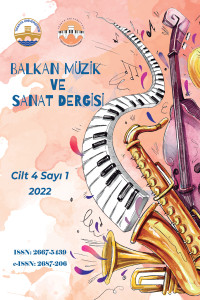Abstract
Polonaise, one of the Polish folk dances, has shown a great development in historical process and got an important place in the repertoire of Western Classical Music. Polonaise did not stay limited to Poland. The relation between Poland and other European countries led polonaise to spread and to change with the effects of different cultures. Polonaise can be found among the compositions of German composers since the eighteenth century.
In the album, which Johann Sebastian Bach presented to Anna Magdalena Bach in 1725, there are polonaises among the pieces in various forms. In these polonaises it can be seen that there are other polonaise rhythms beside the characteristic polonaise rhythm (A1a).
In this research, polonaises from Notebook for Anna Magdalena Bach (BWV Anh. 117a, 117b, 119, 123, 125, 128 and 130) were analysed in rhytmical aspect.
Keywords
Baroque Era Notebook for Anna Magdalena Bach Polonaise Polonaise Rhythms Rhythmical Analysis
References
- Referans1 BACH, Johann Sebastian, Klavierbüchlein für Anna Magdalena Bach, Ed. Georg von Dadelsen, Bärenreiter-Verlag Karl Vötterle GmbH & Co., Almanya 2019.
- Referans2 SIEMENS, Barbara M., “The Piano Genre of the Nineteenth-Century Polonaise”, (Yüksek Lisans Tezi, The University of British Columbia, 2002).
- Referans3 SPRINGTHORPE, Nigel, “The Polonaise and Mazurka in Mid-Eighteenth Century Dresden: Style and Structure in the Music of Johann Christian Roellig”, Eighteenth-Century Music, Cilt 13, Sayı 2, İngiltere 2016, s. 183-209. https://doi.org/10.1017/S147857061600004X
- Referans4 ORON, Aryeh, “Guide to Bach Tour: Dresden”, https://www.bach-cantatas.com/Tour/Dresden.htm (01.09.2022)
Abstract
Polonya halk danslarından biri olan polonez, tarihsel süreç içinde büyük bir gelişim göstermiş ve Klasik Batı Müziği repertuvarı içinde önemli bir yer edinmiştir. Polonez, Polonya ile sınırlı kalmamıştır. Polonya ile Avrupa’daki diğer ülkeler arasındaki ilişki, polonezin yayılmasına ve farklı kültürlerin etkisiyle değişime uğramasına neden olmuştur. On sekizinci yüzyıldan itibaren Alman bestecilerin eserleri arasında poloneze rastlanmaktadır.
Johann Sebastian Bach’ın Anna Magdalena Bach için hazırladığı 1725 tarihli albümde yer alan çeşitli formlardaki parçalar arasında polonezler de yer almaktadır. Bu polonezlerde, karakteristik polonez ritminin (A1a) yanı sıra diğer polonez ritimleri de gözlemlenmektedir.
Bu araştırmada Anna Magdalena Bach Albümü’ndeki BWV Anh. 117a, 117b, 119, 123, 125, 128 ve 130 polonezleri ritmik açıdan incelenmiştir.
References
- Referans1 BACH, Johann Sebastian, Klavierbüchlein für Anna Magdalena Bach, Ed. Georg von Dadelsen, Bärenreiter-Verlag Karl Vötterle GmbH & Co., Almanya 2019.
- Referans2 SIEMENS, Barbara M., “The Piano Genre of the Nineteenth-Century Polonaise”, (Yüksek Lisans Tezi, The University of British Columbia, 2002).
- Referans3 SPRINGTHORPE, Nigel, “The Polonaise and Mazurka in Mid-Eighteenth Century Dresden: Style and Structure in the Music of Johann Christian Roellig”, Eighteenth-Century Music, Cilt 13, Sayı 2, İngiltere 2016, s. 183-209. https://doi.org/10.1017/S147857061600004X
- Referans4 ORON, Aryeh, “Guide to Bach Tour: Dresden”, https://www.bach-cantatas.com/Tour/Dresden.htm (01.09.2022)
Details
| Primary Language | Turkish |
|---|---|
| Subjects | Music |
| Journal Section | Review Article |
| Authors | |
| Publication Date | November 20, 2022 |
| Submission Date | September 2, 2022 |
| Acceptance Date | November 1, 2022 |
| Published in Issue | Year 2022 Volume: 4 Issue: 2 |

Balkan Müzik ve Sanat Dergisi Creative Commons Atıf 4.0 Uluslararası Lisansı ile lisanslanmıştır.


